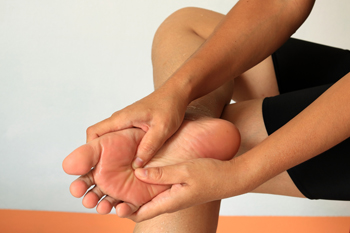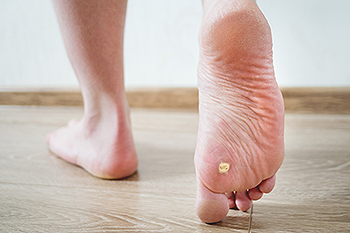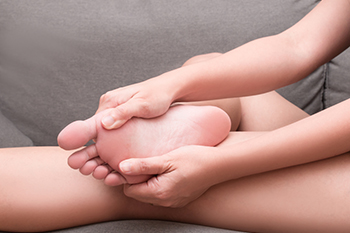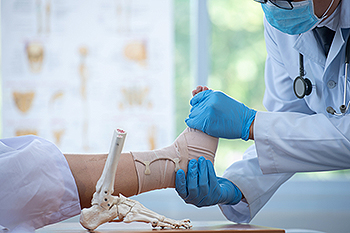
Metatarsal joint pain, or pain in the ball of the foot, commonly results from misalignment of the joint surfaces. This puts pressure on the joint lining and destroys cartilage in the joints. Metatarsophalangeal, or MTP, joint misalignment can be caused by rheumatoid arthritis, a disorder that inflames the joints. In rheumatoid arthritis, hammer toes can develop, which can worsen joint pain and misalignment. Fat tissue, which helps cushion the joints when bearing weight, can be pushed forward under the toes, resulting in a loss of cushioning in the ball of the foot. A lack of cushioning normally occurs as many people age. It can make people more susceptible to pain when the ball of the foot is stressed or injured repeatedly, by running or walking excessively. A loss of cushioning also may cause damage to the nerves of the foot and lead to the development of calluses. MTP joint pain can also result from osteoarthritis or stiffening of the joints of the ball of the foot, often at the big toe joint. Many people with these disorders have an abnormal motion of the foot while bearing weight and walking. Walking is painful for people with metatarsal joint pain. The skin over the joint may feel mildly warm to the touch, and swelling may be present. Over time, pain and stiffening can be disabling. If you are experiencing extreme pain in the ball of the foot, it is suggested that you schedule an appointment with a podiatrist. This specialized foot doctor can examine the foot and suggest appropriate treatment options.
Foot Pain
Foot pain can be extremely painful and debilitating. If you have a foot pain, consult with Barry P. Weinstein, DPM from Bellaire Podiatry. Our doctor will assess your condition and provide you with quality foot and ankle treatment.
Causes
Foot pain is a very broad condition that could be caused by one or more ailments. The most common include:
Diagnosis
To figure out the cause of foot pain, podiatrists utilize several different methods. This can range from simple visual inspections and sensation tests to X-rays and MRI scans. Prior medical history, family medical history, and any recent physical traumatic events will all be taken into consideration for a proper diagnosis.
Treatment
Treatment depends upon the cause of the foot pain. Whether it is resting, staying off the foot, or having surgery; podiatrists have a number of treatment options available for foot pain.
If you have any questions, please feel free to contact one of our offices located in Bellaire and Houston, TX . We offer the newest diagnostic and treatment technologies for all your foot care needs.

Plantar warts, often stealthy intruders on our feet, warrant a closer look to understand their nuances and origins. These warts, caused by the human papillomavirus, or HPV, appear on the soles of the feet. The HPV virus infiltrates the skin through tiny cuts or abrasions, thriving in warm, moist environments, such as communal showers or swimming pools. Plantar warts are characterized by their flat appearance and may have small black dots, often dubbed wart seeds, indicative of clotted blood vessels. The pressure applied to the soles while standing or walking makes these warts grow inward, causing discomfort. While plantar warts are generally harmless, they can be painful and stubborn. Understanding their definition and recognizing the causes including frequenting humid environments, compromised skin, or direct contact with the virus equips individuals to take proactive measures in preventing and addressing these pesky growths on their feet. If you have developed a plantar wart, it is suggested that you consult a podiatrist who can offer effective relief and treatment methods.
Plantar warts can be very uncomfortable. If you need your feet checked, contact Barry P. Weinstein, DPM from Bellaire Podiatry. Our doctor will assist you with all of your foot and ankle needs.
About Plantar Warts
Plantar warts are the result of HPV, or human papillomavirus, getting into open wounds on the feet. They are mostly found on the heels or balls of the feet.
While plantar warts are generally harmless, those experiencing excessive pain or those suffering from diabetes or a compromised immune system require immediate medical care. Plantar warts are easily diagnosed, usually through scraping off a bit of rough skin or by getting a biopsy.
Symptoms
Treatment
To help prevent developing plantar warts, avoid walking barefoot over abrasive surfaces that can cause cuts or wounds for HPV to get into. Avoiding direct contact with other warts, as well as not picking or rubbing existing warts, can help prevent the further spread of plantar warts. However, if you think you have developed plantar warts, speak to your podiatrist. He or she can diagnose the warts on your feet and recommend the appropriate treatment options.
If you have any questions please feel free to contact one of our offices located in Bellaire and Houston, TX . We offer the newest diagnostic and treatment technologies for all your foot and ankle needs.

In a world where fashion often takes precedence over comfort, it is essential for women to be mindful of the long term consequences of their shoe choices. A recent study sheds light on the connection between footwear, specifically high-heels, pumps, and sandals, and the prevalence of foot and ankle pain in women. It revealed a significant association between hind foot pain in women and their past choices of shoes, particularly high-heels and pumps. Nearly 64 percent of women who reported hind foot pain had a history of regularly wearing these types of shoes at some point in their lives. The shoe types were categorized into three groups. Poor shoes were identified as high-heels, pumps, sandals, and slippers. Average shoes included hard or rubber soled shoes and work boots, and good shoes were identified as athletic and casual sneakers. Notably, more than 60 percent of women admitted to wearing shoes in the poor group, compared with two percent of men. The study's findings suggest that past shoe wear, especially choices such as high-heels, may play a significant role in generating foot and ankle pain among women. If you are experiencing pain or discomfort after wearing high heels, it is suggested that you schedule an appointment with a podiatrist for an exam, diagnose and treatment plan.
High heels have a history of causing foot and ankle problems. If you have any concerns about your feet or ankles, contact Barry P. Weinstein, DPM from Bellaire Podiatry. Our doctor can provide the care you need to keep you pain-free and on your feet.
Effects of High Heels on the Feet
High heels are popular shoes among women because of their many styles and societal appeal. Despite this, high heels can still cause many health problems if worn too frequently.
Which Parts of My Body Will Be Affected by High Heels?
What Kinds of Foot Problems Can Develop from Wearing High Heels?
How Can I Still Wear High Heels and Maintain Foot Health?
If you want to wear high heeled shoes, make sure that you are not wearing them every day, as this will help prevent long term physical problems. Try wearing thicker heels as opposed to stilettos to distribute weight more evenly across the feet. Always make sure you are wearing the proper shoes for the right occasion, such as sneakers for exercising. If you walk to work, try carrying your heels with you and changing into them once you arrive at work. Adding inserts to your heels can help cushion your feet and absorb shock. Full foot inserts or metatarsal pads are available.
If you have any questions please feel free to contact one of our offices located in Bellaire and Houston, TX . We offer the newest diagnostic and treatment technologies for all your foot and ankle needs.

There are two sesamoid bones located beneath the big toe which aid its movement. Problems with these sesamoid bones can vary from acute injuries such as turf toe, where the toe excessively bends due to fractures. Pain may also arise from sesamoiditis, an inflammation of the sesamoids, or from arthritis affecting the toe. Symptoms of acute sesamoid issues can manifest as intense pain and difficulty in walking, while chronic conditions may cause persistent pain under the big toe, which can be aggravated by certain shoes or activities, hinting at sesamoiditis. Diagnosis typically involves examining the patient's medical history and symptoms, supported by X-rays or more detailed scans such as an MRI or CT scan. Treatment strategies for sesamoid problems range from wearing supportive footwear and activity modifications. If these measures fail, surgery might be considered, which could include removing the sesamoid bones or repairing them. If you have foot pain of any sort, it is strongly suggested that you make an appointment with a podiatrist who can accurately diagnose the problem and offer treatment options that can help you return to normal activity levels.
Sesamoiditis is an unpleasant foot condition characterized by pain in the balls of the feet. If you think you’re struggling with sesamoiditis, contact Barry P. Weinstein, DPM of Bellaire Podiatry. Our doctor will treat your condition thoroughly and effectively.
Sesamoiditis
Sesamoiditis is a condition of the foot that affects the ball of the foot. It is more common in younger people than it is in older people. It can also occur with people who have begun a new exercise program, since their bodies are adjusting to the new physical regimen. Pain may also be caused by the inflammation of tendons surrounding the bones. It is important to seek treatment in its early stages because if you ignore the pain, this condition can lead to more serious problems such as severe irritation and bone fractures.
Causes of Sesamoiditis
Treatment for sesamoiditis is non-invasive and simple. Doctors may recommend a strict rest period where the patient forgoes most physical activity. This will help give the patient time to heal their feet through limited activity. For serious cases, it is best to speak with your doctor to determine a treatment option that will help your specific needs.
If you have any questions please feel free to contact one of our offices located in Bellaire and Houston, TX . We offer the newest diagnostic and treatment technologies for all your foot and ankle needs.

Plantar fasciitis is a common foot condition that results from inflammation and irritation of the plantar fascia, a thick band of tissue connecting the heel bone to the toes. The hallmark symptom of plantar fasciitis is sharp, stabbing heel pain, which can sometimes radiate along the arch or sole of the foot. Some individuals may experience periodic, temporary flares of intense heel pain, while others may have persistent, chronic discomfort in their feet. This pain is often most intense in the morning or after extended rest, and it typically eases within 10 minutes of walking or stretching. However, it can worsen toward the end of the day due to prolonged standing or activities, like climbing stairs and intense exercise, which can stress the plantar fascia. Inflammation of the plantar fascia can lead to visible swelling and redness around the heel and arch of the foot. Even when not visually swollen, the affected area can feel tender and puffy when touched. Additionally, the condition can affect the Achilles tendon, leading to pain. Tightness in the plantar fascia also can cause the foot to roll inward while walking, increasing stress and tension on the Achilles tendon. If you believe you may have plantar fasciitis, it is suggested that you make an appointment with a podiatrist, a medically trained foot doctor, who is able to help you manage this painful condition.
Plantar fasciitis can be very painful and inconvenient. If you are experiencing heel pain or symptoms of plantar fasciitis, contact Barry P. Weinstein, DPM from Bellaire Podiatry. Our doctor can provide the care you need to keep you pain-free and on your feet.
What Is Plantar Fasciitis?
Plantar fasciitis is the inflammation of the thick band of tissue that runs along the bottom of your foot, known as the plantar fascia, and causes mild to severe heel pain.
What Causes Plantar Fasciitis?
How Can It Be Treated?
While very treatable, plantar fasciitis is definitely not something that should be ignored. Especially in severe cases, speaking to your doctor right away is highly recommended to avoid complications and severe heel pain. Your podiatrist can work with you to provide the appropriate treatment options tailored to your condition.
If you have any questions please feel free to contact one of our offices located in Bellaire and Houston, TX . We offer the newest diagnostic and treatment technologies for all your foot and ankle needs.

Broken ankles, also known as ankle fractures, can vary from minor hairline fractures to severe, multiple fractures. They occur when one or more of the bones that make up the ankle joint are broken. The type of fracture often determines the treatment needed. Simple fractures may need immobilization with a cast or splint to ensure proper alignment during healing. More complex fractures, particularly those where the bones are out of place or the ankle joint is unstable, may require surgery. The surgical intervention aims to realign the bones and secure them in place with screws, plates, or pins. During post-surgery, the ankle is generally immobilized, and weight-bearing may be restricted for a certain period. If you have broken your ankle, it is strongly suggested that you make an appointment with a podiatrist for a proper diagnosis and prompt treatment to reduce the risk of complications.
Broken ankles need immediate treatment. If you are seeking treatment, contact Barry P. Weinstein, DPM from Bellaire Podiatry. Our doctor can provide the care you need to keep you pain-free and on your feet.
Broken Ankles
A broken ankle is experienced when a person fractures their tibia or fibula in the lower leg and ankle area. Both of these bones are attached at the bottom of the leg and combine to form what we know to be our ankle.
When a physician is referring to a break of the ankle, he or she is usually referring to a break in the area where the tibia and fibula are joined to create our ankle joint. Ankles are more prone to fractures because the ankle is an area that suffers a lot of pressure and stress. There are some obvious signs when a person experiences a fractured ankle, and the following symptoms may be present.
Symptoms of a Fractured Ankle
If you suspect an ankle fracture, it is recommended to seek treatment as soon as possible. The sooner you have your podiatrist diagnose the fracture, the quicker you’ll be on the way towards recovery.
If you have any questions, please feel free to contact one of our offices located in Bellaire and Houston, TX . We offer the newest diagnostic and treatment technologies for all your foot care needs.

Foot orthotics, whether over-the-counter or custom-made, are specialized insoles designed to address various foot and gait-related issues. They work by correcting imbalances in foot structure and gait, improving posture, and relieving pain through support and pressure redistribution. Custom orthotics, which are molded to the individual's foot shape, offer a personalized fit ideal for specific alignment problems, pathologies, or deformities. They aid in healing by reducing strain on injured areas and can prevent conditions like stress fractures, tendonitis, and tendon rupture. Orthotics also provide cushioning, shock absorption, and enhanced stability, thereby reducing the risk of falls. Athletes can benefit from custom foot orthotics by improving foot support, limiting shock, and reducing tendon stress. This can enhance performance while minimizing injury risk. Over-the-counter insoles may offer basic comfort but lack the effectiveness of custom orthotics. This makes custom orthotics the preferred choice for those with unique foot-related needs. It is suggested that you make an appointment with a podiatrist to ensure the proper fit and function of orthotics tailored to your individual foot needs.
If you are having discomfort in your feet and would like to try orthotics, contact Barry P. Weinstein, DPM from Bellaire Podiatry. Our doctor can provide the care you need to keep you pain-free and on your feet.
What Are Orthotics?
Orthotics are inserts you can place into your shoes to help with a variety of foot problems such as flat feet or foot pain. Orthotics provide relief and comfort for minor foot and heel pain but can’t correct serious biomechanical problems in your feet.
Over-the-Counter Inserts
Orthotics come in a wide variety of over-the-counter inserts that are used to treat foot pain, heel pain, and minor problems. For example, arch supports can be inserted into your shoes to help correct overarched or flat feet, while gel insoles are often used because they provide comfort and relief from foot and heel pain by alleviating pressure.
Prescription Orthotics
If over-the-counter inserts don’t work for you or if you have a more severe foot concern, it is possible to have your podiatrist prescribe custom orthotics. These high-quality inserts are designed to treat problems such as abnormal motion, plantar fasciitis, and severe forms of heel pain. They can even be used to help patients suffering from diabetes by treating foot ulcers and painful calluses and are usually molded to your feet individually, which allows them to provide full support and comfort.
If you are experiencing minor to severe foot or heel pain, it’s recommended to speak with your podiatrist about the possibilities of using orthotics. A podiatrist can determine which type of orthotic is right for you and allow you to take the first steps towards being pain-free.
If you have any questions please contact one of our offices located in Bellaire and Houston, TX . We offer the newest diagnostic and treatment technologies for all your foot and ankle needs.

Metatarsalgia, a prevalent foot condition, can disrupt daily life with pain and discomfort. Symptoms of metatarsalgia include sharp, aching, or burning pain in the ball of the foot. This discomfort may extend to the areas around the second, third, or fourth toes. Pain may worsen when standing, walking, or running but eases when resting. Some individuals may experience sharp or shooting pain in their toes, tingling sensations, or the sensation of walking with a pebble in their shoe. Walking barefoot, especially on hard surfaces, can intensify the pain. Metatarsalgia can be due to intense physical activities, such as running or jumping, particularly when combined with improperly fitting or worn-out shoes. Conditions like hammertoes, bunions, and excess body weight can also contribute to metatarsalgia. Furthermore, footwear choices play a role, with high heels, narrow-toed shoes, and non-supportive athletic footwear increasing the risk. Stress fractures in the metatarsals or toe bones and Morton's neuroma can contribute to this condition. If you are experiencing pain or discomfort in the ball of the foot, it is suggested that you make an appointment with a podiatrist for an exam and possible treatment solutions.
Sports related foot and ankle injuries require proper treatment before players can go back to their regular routines. For more information, contact Barry P. Weinstein, DPM of Bellaire Podiatry. Our doctor can provide the care you need to keep you pain-free and on your feet.
Sports Related Foot and Ankle Injuries
Foot and ankle injuries are a common occurrence when it comes to athletes of any sport. While many athletes dismiss the initial aches and pains, the truth is that ignoring potential foot and ankle injuries can lead to serious problems. As athletes continue to place pressure and strain the area further, a mild injury can turn into something as serious as a rupture and may lead to a permanent disability. There are many factors that contribute to sports related foot and ankle injuries, which include failure to warm up properly, not providing support or wearing bad footwear. Common injuries and conditions athletes face, including:
Sports related injuries are commonly treated using the RICE method. This includes rest, applying ice to the injured area, compression and elevating the ankle. More serious sprains and injuries may require surgery, which could include arthroscopic and reconstructive surgery. Rehabilitation and therapy may also be required in order to get any recovering athlete to become fully functional again. Any unusual aches and pains an athlete sustains must be evaluated by a licensed, reputable medical professional.
If you have any questions please feel free to contact one of our offices located in Bellaire and Houston, TX . We offer the newest diagnostic and treatment technologies for all your foot and ankle needs.